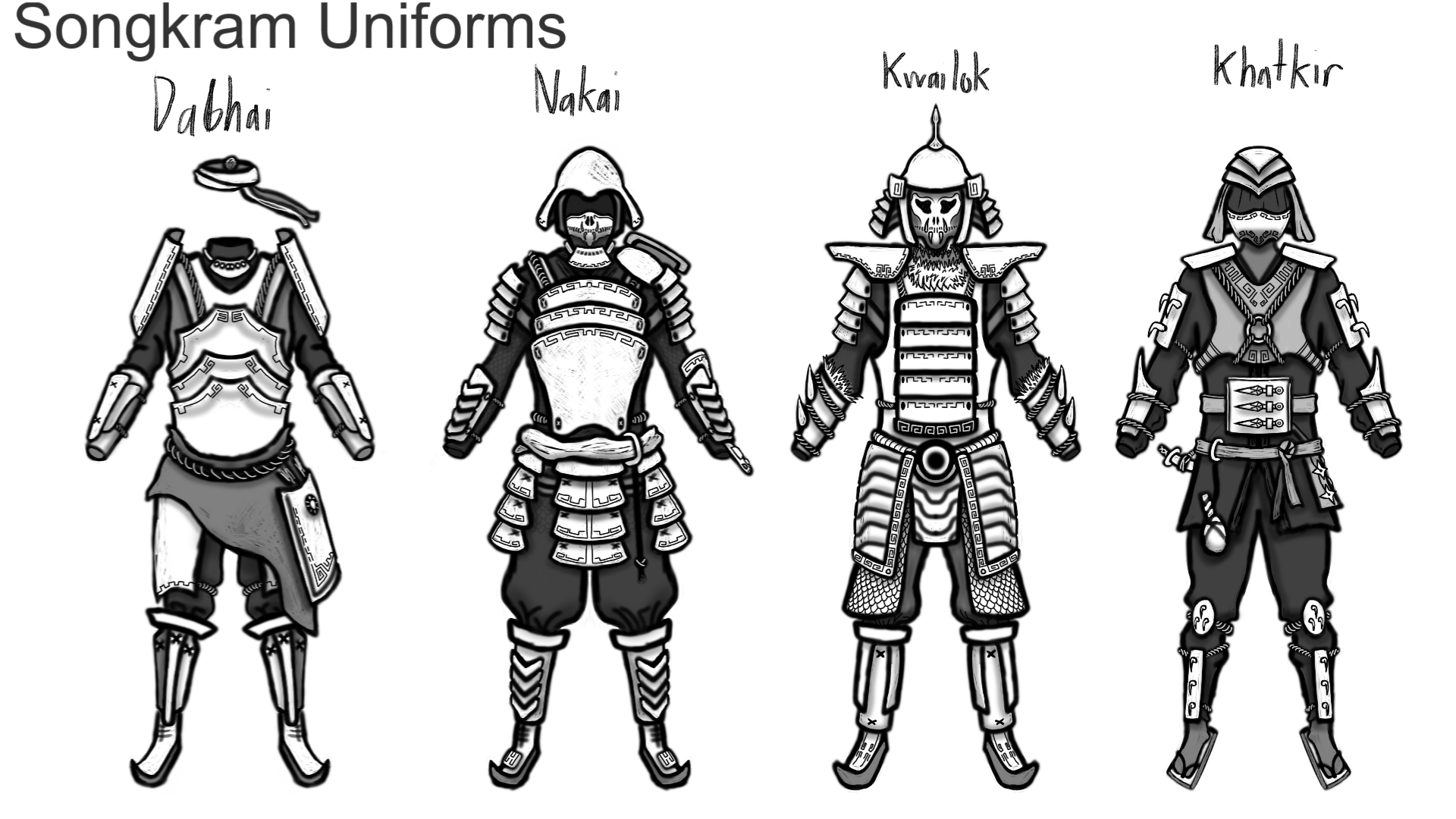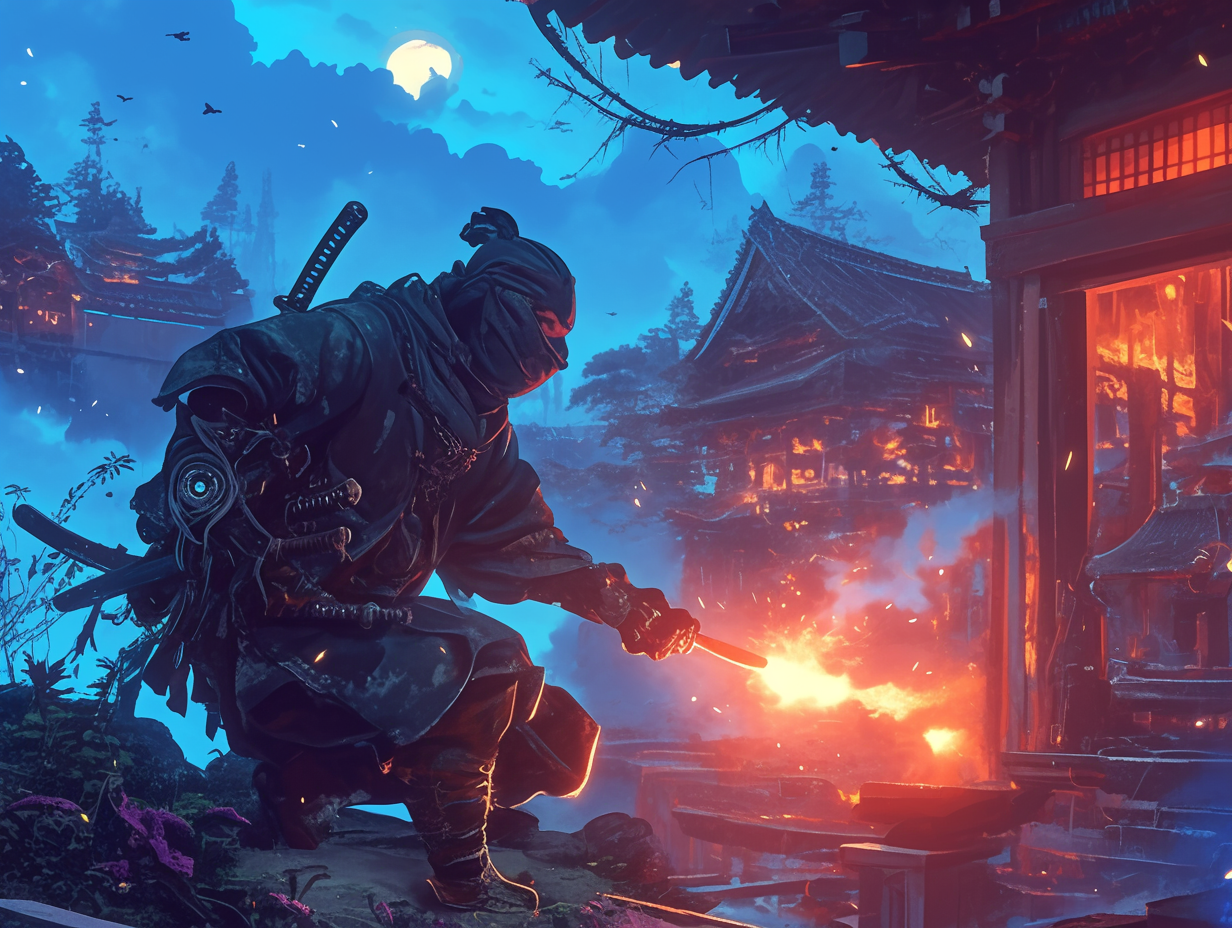Khatkir
Khatkir were intelligence officers employed by Isutan governments that gathered information, executed sabotage, and performed assassinations. Khatkir became an icon of fear during the reign of the Songkram Empire, as they became a secret police force embedded within the population to ensure that any sign of rebellion against the government was squashed.

A lone khatkir operative causes a disturbance in hopes that her companions will be able to secure documents with ease.
Composition #
Manpower #
Khatkir did not work in large squads but might have joined forces in groups of 2 or 3 to tackle a particular assignment. Typically, the number of khatkir involved in something was kept low to avoid liabilities, but they made sure that there were sufficient numbers to accomplish their goal. There was a common myth that khatkir only ever worked alone—this couldn't have been farther from the truth. There was a good chance that the khatkir only allowed people to see who they wanted people to see.
Structure #
Similar to Nakai, khatkir reported to a nakai grandmaster. As grandmasters were responsible for troop movements on the battlefield, they relied on khatkir to relay crucial information to them in order to make tactical decisions. During more peaceful times, a khatkir still reported to their respective grandmaster, but it was up to the grandmaster to relay the information to their Ganpoumi Fi councilor or the Songkram Warlord. Nakai masters were allowed to request khatkir to carry out certain acts, but khatkir reserved the right to decline carrying out the order if they believed it was not in the best interest of the grandmaster.
Equipment #
Khatkir equipment was not standardized, as agents only equipped themselves with the tools required to complete a job. For example, a khatkir tasked with monitoring the streets might have disguised themselves as a beggar on the side of the road; very little to no gear was required for such a task. On the other hand, khatkir might have decked themselves in armor and carried a multitude of climbing implements, explosives, and other devices if they were assigned to a sabotage mission in an enemy camp during wartime. Thus, there was no standard for khatkir gear. That being said, some of the more common pieces of gear used by khatkir included grappling hooks, smoke bombs, yin keon, and hand mirrors. Other more offensive tools like traps included nail bombs, caltrops, and Sluggdon mucus (for creating slippery surfaces).

Khatkir engaging in combat often wore cloth and leather armor simply to avoid making noise. Embedded sheets of starsteel were usually slipped in between folds of specialized clothing to help provide a little more protection. Khatkir who chose to engage in hand-to-hand combat might have also donned spiked armor, which helped intimidate and provided innate counterattacks against opponents who were similarly bare-knuckled.
Weaponry #
As mentioned earlier, khatkir lacked a standard of equipment due to the different tasks they might have been assigned to. Similarly, the weapons of a khatkir were not regular either.
Swords #
Kizarakas[^1] were a common weapon to see on khatkir as they were trained to use such a weapon just like Nakai. Usually, a khatkir's kizarakas were shorter in length, sometimes with a short enough blade to be used one-handed. These miniature kizaraka were called sangha and were more easily concealed in a disguise. Sanghas' compact nature helped to avoid getting in the way if a khatkir was on a mission that required more intense athletic acts like rock climbing.
Interchangeable Headed Weapon/Multitool - Yin Keon #
One weapon not used by nakai and exclusively wielded by khatkir was the yin keon, a pata-type weapon that could change its attachment based on the situation. The "handle" of the yin keon was a half orb of starsteel metal with a grip running across its insides. There was a screw hole bored into the front of the orb, perpendicular to the grip. With this hole, the khatkir could attach a number of different blades, hooks, or other more utility-based heads to the handle. Yin keon were used by khatkir in a more offensive scenario—say, directly on the battlefield or in an otherwise hostile environment.
Ring and Weight Rope - Chin Han #
A simple weapon consisting of a starsteel ring with sharpened edges connected to a heavy metal weight by a durable cord. Easily concealable, the chin han acted not only as a deadly weapon but as a tool for climbing. Khatkir acting as undercover police often used such a weapon to ensnare criminals.
Tactics #
In battle, khatkir were rarely seen on the battlefield but sometimes made an appearance if allied forces required more manpower in taking a specific objective. The main roles khatkir played in war were sabotage, espionage, and assassination. Khatkir often communicated with one another using codes or a unique novel language specific to associated operatives.
Pythoness Khatkir
While the Ganpoumi Fi frowned upon such practices, early Isutan kingdoms as well as the Songkram Empire utilized a special class of khatkir they called pythonesses. Pythonesses were women who infiltrated the homes of enemies, causing all sorts of destabilization by initiating affairs, planting seeds of doubt, and employing other methods of psychological warfare.
They were rarely trained for actual combat beyond self-defense, although in some situations it was not unheard of to have a pythoness perform an assassination if time was of the essence.
Pythonesses were used by the Ganpoumi Fi, but mainly as a tool in the initial unification of The Eastern Provinces. The federation largely abhorred how their predecessors used pythonesses; allowing them to be mistreated harshly by their marks before being tossed aside like consumable resources.

An attractively-dressed pythoness khatkir meets a young nobleman in hopes of making him unfaithful.
While pythonesss were exclusively women, both male and female individuals were used as traditional khatkir in Isutan intelligence toolboxes.
Sabotage #
Khatkir carried explosives, wood saws, or magical compounds in order to tamper with enemy siege engines, compromise the integrity of weapons and armor, or commit other nefarious acts sure to give their allies the upper hand without the foe realizing it (until it was too late, of course).
A Famous Historical Example
There was once a group of khatkir raised a generation of Skymetal Piranha Fly and loosed them in the weapon stores of an enemy encampment, robbing them of intact equipment come the following day when the nakai marched on them.

A khatkir agent prepares to set alight a village's rice storehouse.
In exceedingly uncommon scenarios, khatkir would act as suicide bombers. However, this practice was considered ineffective because of how much training the average khatkir underwent--suicide bombing would be seen as a waste of resources.
Espionage #
Khatkir learned many languages. When combined with their sharpened memories, khatkir could become living cameras/tape recorders of information. Khatkir were also masters of disguise, taught how to change their face with makeup in order to appear more like the enemy. This allowed them to infiltrate deep into enemy camps and sometimes courts. Naturally, khatkir were excellent at pickpocketing, lockpicking, and general thievery. Outside of war, khatkir roamed the streets of cities and villages, exploring businesses and restaurants or criminal activity and reporting it to the authorities. While the Ganpoumi Fi leveraged the khatkir to help maintain peace, the Songkram wielded the khatkir to inspire fear of the government.
During the earlier days of the Eastern Kingdoms, khatkir seductresses were disseminated across rival territories in attempts to destabilize loyalties. Comedically, the Ganpoumi Fi leveraged many of these relations as a way to help ease otherwise stubborn men into unifying their provinces with others. ^5da92a

A khatkir agent subtly extracts information from his target while engaging in a game of rafupangthai.
Assassination #
Much like the other jobs khatkir carried out, the assassination of targets might have been something that could prove beneficial to allied forces. Examples included taking out enemy captains or military leaders, or sometimes more drastic approaches like murdering an entire enemy squad in their sleep. Ironically, assassination was far more common during times of peace rather than during war—at least, during the Songkram's rule. As the khatkir acted as the secret police of the Songkram, they were often tasked with disposing of problematic individuals with anti-Songkram sentiments. Khatkir were ruthless and merciless, willingly killing such targets regardless of age, gender, or level of extremism.

A keen-eyed khatkir sniper prepares to execute a dissident from his window.
Guerrilla Warfare #
As mentioned earlier, khatkir were not often visible on the battlefield, but their presence was felt as equally as a Nakai's. Khatkir often struck at opposing forces while they were moving—this could involve anything from ambushes to the laying of traps in their path. Classic strategies for guerrilla warfare included punji stick-filled pits or primed rockslides.
Training #
Khatkir intensive training took place over the course of 1-2 years on top of the 20 years of training that Nakai underwent. This training was only available to graduated, fully-fledged nakai who passed an "entrance exam" to test whether or not the nakai had the mental fortitude to act as a khatkir. Over the course of their education, khatkir were taught how to speak and write in almost every language on Legere. They also underwent training in memorization, athleticism like freerunning and parkour, survival skills, and a plethora of other abilities that were invaluable for an effective and efficient spy. Khatkir had to complete another exam upon completion of their training, as well as a series of tests to evaluate the other skills that they were taught. These tests were rigorous and extensive, taking place over the course of several months to thoroughly ensure that all khatkir had become skilled enough to carry out tasks.
An important thing to note was that while a khatkir trainee might have failed at these tests, they were nonlethal—even during the Songkram's reign. As far as the Songkram were concerned, once someone had graduated as a nakai, they had proved themselves.
Logistics #
Upkeep #
In order to have khatkir maintain cover, nakai grandmasters often arranged "drop points" for supplies to be received by khatkir agents without them blowing cover. This could be something as simple as hiding tools and weapons in tree stumps, or something more sophisticated like buying a "special order" from a shop. Thankfully, khatkir were extremely self-sufficient due to their training. "Refueling" khatkir agents wasn't required unless specific tools were needed that the khatkir couldn't get inconspicuously or hand-make.
Recruitment #
Khatkir came from nakai graduates who were either picked by grandmasters who noticed their natural aptitude, or nakai graduates who desired to become khatkir of their own volition. Either way, potential khatkir trainees were all welcome to try and pass the entrance exam.
[^1]: The kizaraka was the standard weapon within the The Eastern Provinces, being a single-edge, curved sword with a small, round handguard.